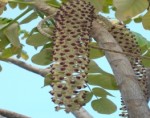Scientific Name: Munroidendron racemosum
Endemic, Endangered: Kaua’i
Description: Trippy is the first words that come to mind. When I first saw a full grown specimen of this plant (which reaches heights between 15-25 feet) I couldn’t believe it came from somewhere in Hawaii, I take it back, I couldn’t believe it came from anywhere on Earth! At least not present day Earth. This plant looks like it came straight out of Jurassic Park. Its thick, hairy leaves and flowering/fruit stalk look unlike any other plant most people are familiar with. The leaves are made up of smaller leaflets that are covered with tiny white hairs that help it reflect sunlight and retain moisture but at the same time give it an almost ‘wooly’ appearance. The flowering stalk hangs down like a pony tail from the branches, is about 2 feet long and is completely covered with yellow, star shaped flowers. Once these flowers are pollinated they develop into plump, fuzzy white fruit with a dark purple circle on the outer facing side and dark purple pulp on the inside, very cool and unusual looking, for real.
Distribution: This is a super duper, not even joking, hurry up and do something, almost pau, no more nothing left tree. It’s listed as an endangered species but so are about ¼ of our native plants, it should be in a separate category along with a bunch of other plants that are on the verge of extinction. Naturally this plant resides with only three very small populations on the island of Kaua’i so when I say that it looks like it came straight out of Jurassic Park that’s half way true because a lot of the movie was filmed on Kaua’i and just like the animals in that movie, this plant will be extinct soon if were not careful.
Cultural Uses: No cultural uses are known at this time for this plant, however the fruit is edible and quite sweet (it will turn your whole mouth purple) but there is no documentation that suggests it was regularly eaten. In fact, it is so rare that there is no known Hawaiian name.
Landscape Uses and Care: Don’t be scared away with what this plant looks like in a small one gallon pot like how they are in the store, it gives them no justice as to how incredible they look when mature, this plant speaks wisdom. Water it daily until the plant is established in the ground (until you see signs of active growth) then slowly cut back on your watering schedule. Spider mites and aphids occasionally occur on young or newly transplanted plants but these pests can be treated with store bought pesticides or simply by spraying them off with water.
Additional Info: This endangered plant comes from the same family (Arialacea) of plants as the highly invasive octopus tree (Schefflera actinophylla) which is taking over much of our native mesic forests, they same forest that this truly Hawaiian plant, along with its other native relatives, used to thrive in.
Munroidendron
